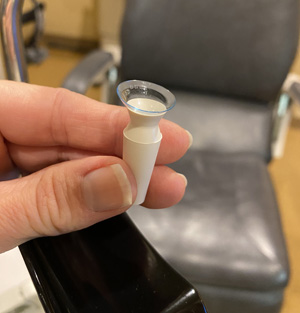Since 1961, the Eye Bank Association of America has provided donors for more than 1.5 million corneal transplants nationwide. And for nearly 25 years, the group has celebrated corneal transplant recipients, promoted awareness of the need to donate and recognized donors and families during National Eye Donor Month in March.

But Charleen Heyduck of Huntingdon, Tennessee, celebrates every day. It’s been nine years since her double corneal transplants at Vanderbilt Eye Institute, performed by Uyen Tran, M.D.
“It has really been astounding what this transplant has done,” said Heyduck. “After having the surgeries, I can function. I can see and I don’t even need glasses except to read.
“I told Dr. Tran that she had given my life back to me.”
Tran, associate professor of clinical Ophthalmology and Visual Sciences, said Vanderbilt performs about 200 transplants annually. More than 40,000 are done every year in the United States.
The cornea is the clear outer lens on the front of the eye. Corneal transplants are often the result of three causes: infections, inherited conditions and inflammatory diseases.
Heyduck required a transplant in 2007 after both of her corneas became excessively cloudy due to Fuchs’ dystrophy, a condition that causes a gradual decline in vision due to swelling and clouding of the cornea.
Symptoms included sensitivity to light, eye pain and blurred vision.
“The light was so painful that I had to wear sunglasses indoors,” said Heyduck. “My vision was like looking through one of those old shower doors with the bumpy glass. I could read or watch TV, but not very well. I wasn’t blind, but it was very limiting.”
Tran said most transplants last about 20 years. In rare instances, the patient’s body can reject the graft, but most of these cases can be reversed with steroid eye drops.
Traditionally there has not been a shortage of corneas for transplantation, said Tran, but the increase in LASIK surgeries might change that in the future. LASIK, a popular vision correction surgery, reshape the cornea for common conditions like nearsightedness, farsightedness and astigmatism.
“I am worried about how LASIK will impact cornea availability,” said Tran. “LASIK thins the corneas, which makes them unsuitable for donation.
“I am also concerned about the number of transplants we perform due to infections caused by improper contact lens use. I see so many patients with ulcers from sleeping or swimming in their contact lens. The ulcers can cloud the cornea and melt it as well.”
For now, Tran and other cornea specialists champion the ability to restore vision through corneal transplants and encourage the gift of eyesight through organ donation registries.















